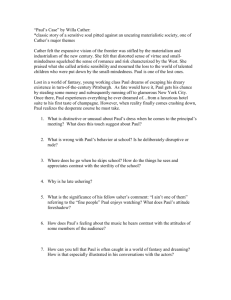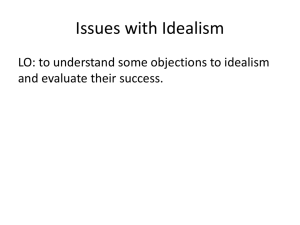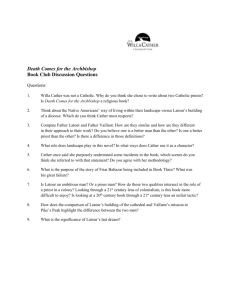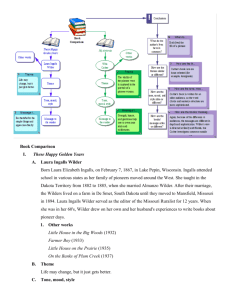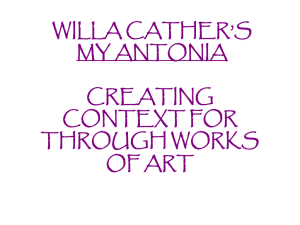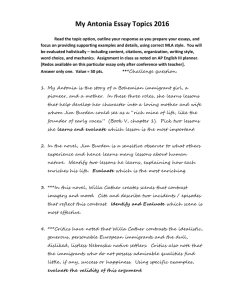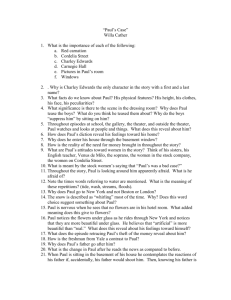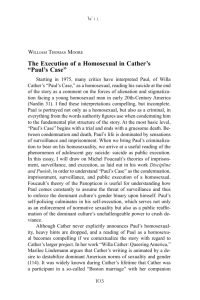Exemplar - English 30
advertisement
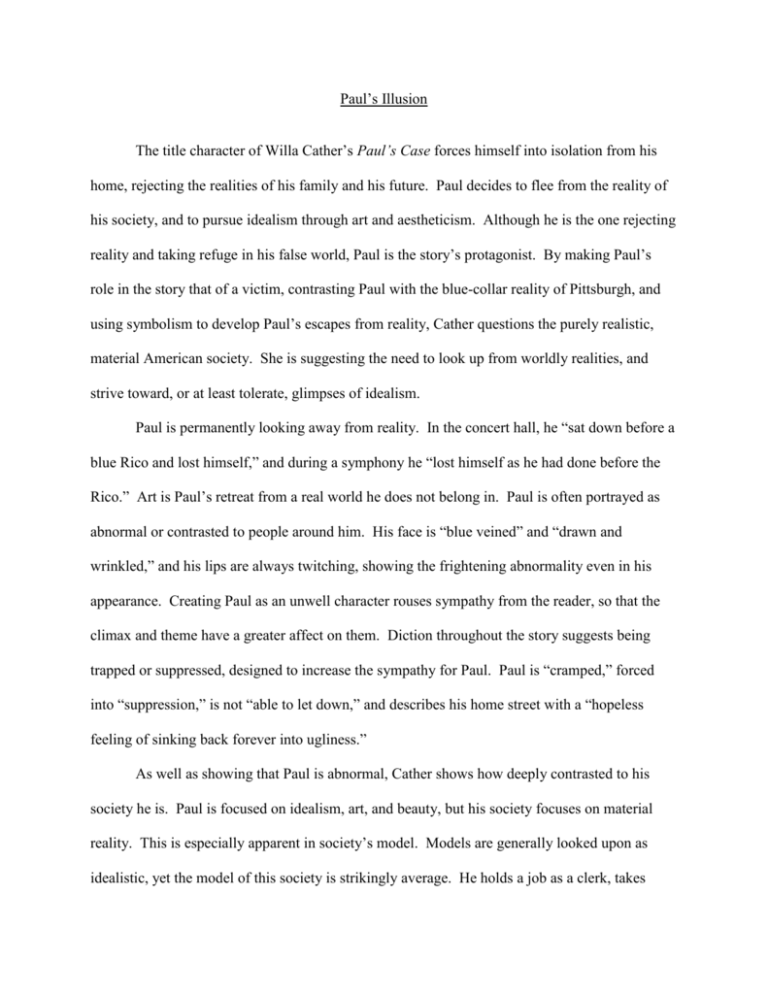
Paul’s Illusion The title character of Willa Cather’s Paul’s Case forces himself into isolation from his home, rejecting the realities of his family and his future. Paul decides to flee from the reality of his society, and to pursue idealism through art and aestheticism. Although he is the one rejecting reality and taking refuge in his false world, Paul is the story’s protagonist. By making Paul’s role in the story that of a victim, contrasting Paul with the blue-collar reality of Pittsburgh, and using symbolism to develop Paul’s escapes from reality, Cather questions the purely realistic, material American society. She is suggesting the need to look up from worldly realities, and strive toward, or at least tolerate, glimpses of idealism. Paul is permanently looking away from reality. In the concert hall, he “sat down before a blue Rico and lost himself,” and during a symphony he “lost himself as he had done before the Rico.” Art is Paul’s retreat from a real world he does not belong in. Paul is often portrayed as abnormal or contrasted to people around him. His face is “blue veined” and “drawn and wrinkled,” and his lips are always twitching, showing the frightening abnormality even in his appearance. Creating Paul as an unwell character rouses sympathy from the reader, so that the climax and theme have a greater affect on them. Diction throughout the story suggests being trapped or suppressed, designed to increase the sympathy for Paul. Paul is “cramped,” forced into “suppression,” is not “able to let down,” and describes his home street with a “hopeless feeling of sinking back forever into ugliness.” As well as showing that Paul is abnormal, Cather shows how deeply contrasted to his society he is. Paul is focused on idealism, art, and beauty, but his society focuses on material reality. This is especially apparent in society’s model. Models are generally looked upon as idealistic, yet the model of this society is strikingly average. He holds a job as a clerk, takes orders well, and did not marry notably for love: “He…had married the first woman whom he could persuade to share his fortunes.” This woman is also a schoolmistress, used in the story to show uptight dedication to gritty material reality and, therefore, aversion to Paul. Cather uses this model, his life and his nearsightedness to critique the society which has no mind for the beauties of idealism. Paul is opposite to this model in every way. The model’s motives are monetary, Paul’s are aesthetic, the model values hard work, Paul enjoys rest and pleasure. Also, Paul has nothing in common with his peers, who tease his stories and even bully him. Paul is presented with the society and models of Cordelia Street as his own model: even the name Cordelia stems from a Latin anagram meaning “ideal centre.” However, he cannot converge into the society, and his dissociation with this falsely ideal world contrasts Paul’s idealism with quantitative reality, and stresses Paul’s role as a victim to this reality. Paul is a quiet boy; in fact, the name Paul means “small, humble.” Instead of intrepid action or moving struggle, Paul uses retreat and denial to escape harsh reality. Art is a recurring symbol which is the embodiment of Paul’s escapes. Flowers also suggest his refuge in beauty: He specially requests flowers in his New York room, is pleased by other flowers he sees in New York City, and Cather always describes flowers in detail. Before his suicide, “Paul took one of the blossoms carefully from his coat and… covered it up.” Moments before killing himself, Paul is setting aside his illusionary world to remove himself from reality altogether. Another interesting symbol involves Paul himself and his conflict with his society. Paul and his getaways suggest the ephemeral idealist world he hides in, and the world and people around him suggest unnacepting reality. As reality draws closer to Paul in the form of his searching father, Paul and his ideal illusion are pushed ever closer to suicide. The suicide when Paul “dropped back into the immense design of things” shows that Paul is consumed by the society of reality. Cather’s entire plot shows the rejection of idealism against the truth of worldly society. Paul is the protagonist and was developed in abnormality and contrast to the antagonistic material world he lives in. Though the world represents truth, it is a skewed truth obsessed with numbers and wealth, and Paul represents an aesthetic escape from this world. However, Cather did not develop Paul as the panacea to society’s wealth affliction. His peculiarities and especially his suicide show that he takes his idealism too far. Paul’s fascination with aestheticism becomes more and more an addiction as the story passes. It begins innocently, but grows into lies and crime which snowball into suicide. By using this crushing addiction rather than hailing Paul as a hero to fix the world’s errors, Cather creates flaws in Paul as well as in the society. Her story shows that pure, illusionary idealism like Paul’s leads to dangerous withdrawal, but especially shows that our society is afflicted by an utter lack of idealism, a nearsighted hunger for wealth which may end up consuming us.
